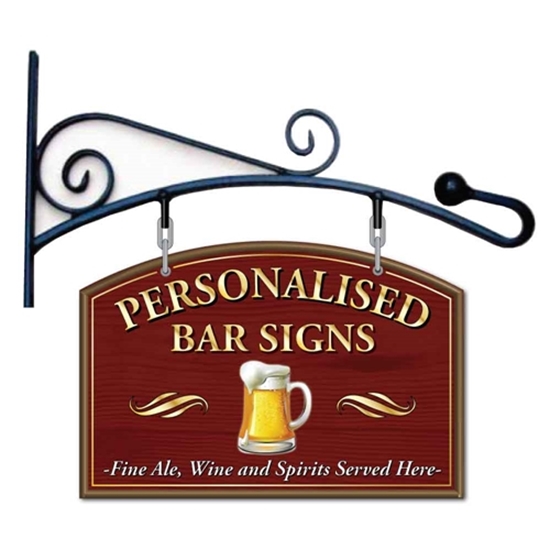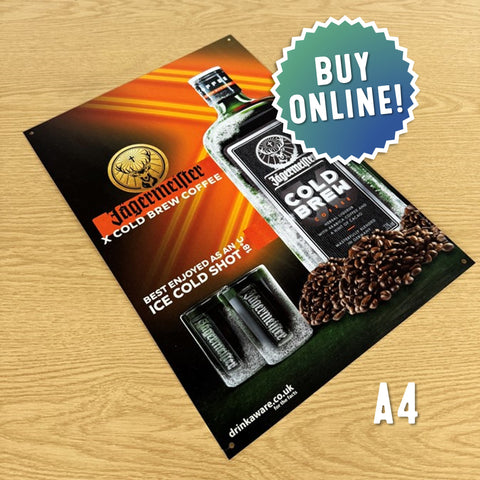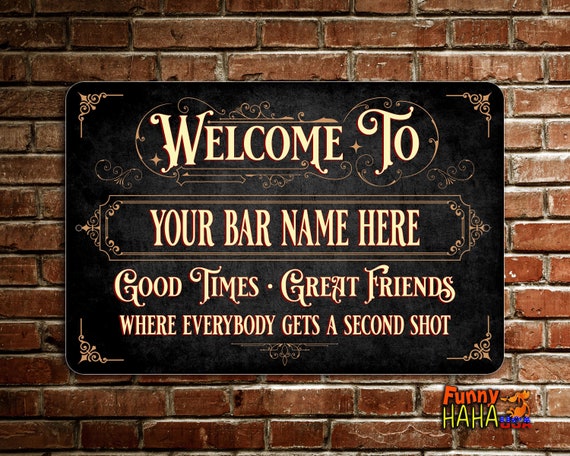Top News On Choosing Hanging Signs
Wiki Article
What's The Distinction Between The Bar's Signs In Terms Of The Location?
Location, design and location of bar signage are crafted to maximize effectiveness in certain areas. The place of the bar signs will influence their appearance. Exterior Signs
The intention behind the sign is to attract patrons and create an brand identity for the bar.
Features: Large, eye attractive and often illuminated to increase visibility at night.
Material: Sturdy materials such as neon vinyl, or weather resistant vinyl.
It is also possible to put up a marquee sign at the entrance area to display your logo and main bar name.
2. Entrance Signs
The purpose of the welcome card is to offer information and welcome customers.
Features: Crisp and inviting, often using branding elements.
Materials include: Metal signs, wood signs, and illuminated signs.
Examples: "Welcome' signs, operational hours or special announcements.
3. Interior Wall Signs
Purposes: To enhance décor, provide info and create ambiance.
Features: Various in both size and style to fit with interior decor.
Materials: Wood, metal, chalkboard, acrylic.
For example, you can make use of inspirational quotes, menu boards, and themed décor.
4. Behind the Bar Signs
The aim of this is to bring out the key elements in the bar such as its name, its signature cocktails and the latest specials.
Features The central point of the room is noticeable and well-lit.
Materials: neon, LED, digital display, chalkboard or other materials.
Examples: Bar name signs, drink specials boards, and digital menu displays.
5. Ceiling and hanging signs
Use: For information on direction or to improve the decoration.
Features: Suspended at the ceiling. Visible from all angles.
Materials That are lightweight like metal and acrylic foam board.
For example: hanging decorative signs, or themed props.
6. Tabletop Signs
Use: Provide patrons with details specific to their table.
Features: Small and easily readable when close-up.
Materials The materials are: wood laminated with acrylic or paper.
Examples include Drink Menus Table Numbers, Promotional Cards, and QR Code Stands.
7. Restroom Signs
Utilization: To clearly identify the exact location and the type of restrooms.
Features: Usually, they are large, clear symbols or text.
Materials: Metal, plastic, wood.
Examples: Men's and women's restroom signs, non-sex restroom signs.
8. Directional signs
The purpose of this sign is to guide patrons to the various areas within the bar.
Features: Clear arrows and labels that are easy to read.
Materials: Metal, acrylic, wood.
Examples: Signs pointing towards restrooms, exits, or different seating areas.
9. Window Signs
Purpose: To make the bar more visible and inform passersby.
Features: Easily visible from outside, usually including lighting.
Materials: Vinyl decals, neon, LED.
Examples: Advertisements, promotional signs, event announcements and operating hours.
10. Signs for events and promotions
Information on seasonal deals and promotions as well as special occasions.
Features: Often short-lived and attractive.
Materials: Foamboard, vinyl, and chalkboard.
Examples: Event posters, promotion banners, and chalkboard promotions.
Location-Specific Considerations
Visibility
Exterior and entrance signs: They must be easily visible in order to draw customers.
Interior and Behind The Bar Signs Should be strategically placed for maximum Impact and Readability.
Durability
Exterior Signs - Materials should be weatherproof in order to stand up to outdoor conditions.
Interior Signs are an excellent choice as they are made from a range of different materials.
Aesthetic Integration
Decorative and behind-the-bar signs These signs should be in harmony with the design and theme of the bar.
Directional and informative signs should blend in with the decor.
Functionality
Directions and restroom signs Signs for Directions and Restrooms easily readable and clearly displayed so that patrons are able to find their way around.
Promoter and event signs should be temporary or changeable to reflect the latest offers.
Lighting
Window and exterior signs: Illuminated to improve visibility at night.
Signs for the inside and behind-the-bar may employ lighting to highlight specific areas or create ambiance.
Bar patrons can create a welcoming atmosphere by customizing the design, material, and placement of signs for their bar. Follow the best her response for cocktail bar sign for site advice including hanging pub signs personalised, bar signs for home, pub sign hanging, personalised bar signs, personalised garden pub sign, garden bar sign personalised, hanging bar sign, pub sign design ideas, to the bar sign, bar hanging sign and more.

How Do Bar Signs Differ In Terms Of Readability?
The size and readability of bar signs is influenced by a variety of factors like font selection and contrast of colors, location, and lighting. These variables can affect the readability and effectiveness of signs for bars. Font Choice
Signs are identified by the typefaces they employ.
Readable Fonts Simple, sans-serif fonts such as Arial, Helvetica, or straight serif fonts like Times New Roman.
Stylized Fonts: The decorative or script fonts may be harder to read, especially at a distance or in low light.
Simple, legible fonts aid customers quickly comprehend the information.
2. Font Size
Specifications: Text size on the sign.
Large Fonts - Ideal for signage and outdoor use.
Small Fonts - Ideal for menus, tabletop signs and other displays that are close-up.
Impact: Appropriate font size is crucial for readability at various distances. Text that is larger is more easy to read from a distance.
3. Color Contrast
Characteristics of the font: the contrast in color between the text and the backdrop.
High Contrast: Dark text against a lighter background or lighter text on an darker background (e.g. black on white, or white on black).
Low contrast: Text may be difficult to read if the hues of the background and text are similar.
High contrast text increases the readability.
4. Lighting
Specifications: How the sign is lit.
Well-lit signs: Signs which are front or back lit improve visibility in low light conditions.
Signs that are poorly lit: Signs without adequate lighting can be difficult to read at night or in dimly lit areas.
The impact: Proper lighting can make sure that signs are visible and understood at all times. This is especially important in dim environments.
5. Material and Finish
Specifications: The kind of finish and material that is that is used to create the sign.
Matte finish reduces glare. Text will be much easier to read.
Glossy Finish - Can cause reflections under direct light, that can make it hard to read.
Impact: The proper materials and finishes can increase readability, by minimizing reflections and glare.
6. Text Layout
Specifications The arrangement of the words on the sign.
Clear Hierarchy. Organize information using headings.
Unorganized Layout Signs that are difficult to read may be cluttered with a lot of text or have a design that's overly complex.
The impact: A well-organized, clear layout makes it easy for users to find and grasp information.
7. Viewing distance
Specifications The distance at where the sign is intended to be read.
Long Distance: Larger text and high contrast are important.
Short distance: It is acceptable to reduce the size of the text however, it is vital to keep the clarity and simplicity intact.
The impact of signs is made to be read with the intended reading distance in your mind.
8. Placement
The signage's location within the bar.
Ideal placement: near the eye, clear of obstructions and well-lit.
Poor Placement - High behind objects or in dark areas.
Effect: Properly placed signage will ensure that the patrons are able to easily read and comprehend them.
Signs with Text that is Readable Examples
Exterior Signs
The characteristics are: Large, high-contrast text that is well-lit (e.g. neon or backlit), and placed prominently.
The impact: It draws attention from customers and is observed from a distance.
Menu Boards
The main characteristics are large text, clear headings for items, and backlit or chalkboards with adequate lighting.
Effect: Customers are able to easily decide and read their orders. This makes their experience more enjoyable.
Directional Signs
Characteristics : simple arrows with big text, and a high-contrast.
Impact: Helps patrons navigate the space effortlessly which improves overall flow and satisfaction.
Promotional signs
Specifications: Bold text for advertising, high contrast, well-lit, positioned in areas with high traffic.
Impact: Effectively communicates offers and occasions to customers, encouraging engagement.
Factors Affecting Readability
Ambient lighting in bars, and the overall atmosphere of a bar may affect the quality of signage that is displayed. Bright, well-lit environments enhance reading ability.
patron movement: The signs in busy bars need to be easily read by patrons moving about. The large, high-contrast font is helpful in these situations.
It is important to update signs regularly, especially in cases where they change frequently, like daily specials.
By making sure they pay attention to these elements bar owners can make sure they display signs that are not only visually appealing but also comprehendible, enhancing the overall customer experience. Have a look at the top hanging signs for more info including personalised cocktail bar sign, pub wall sign, novelty bar signs, home pub signs, indoor bar signs, the pub sign, personalised hanging pub signs, hanging tavern sign, large bar signs, bar sign design and more.

What Is The Distinction Between Brand Signs As Well As Bar Signposts?
Bar signs play a crucial function in branding. They convey the character of a place along with its style and image. What distinguishes bar signs in the sense of branding. Logo and Brand Identity
Logo Integration: Placing the logo of the bar prominently on signage creates brand recognition and helps establish the bar's brand identity.
Consistent branding: Signs must to be consistent with other branding tools such as menus. coasters as well as social media profiles, and other.
2. Visual Style and design
Thematic Design: Signs reflect the theme and atmosphere of the bar, no matter if it's a cozy pub, elegant lounge or a lively nightclub.
Custom Graphics Typefaces, graphics, and imagery that are unique will help distinguish your brand and draw customers.
3. Color Scheme
Branded Colors. Utilizing a bar's brand colors on the signage can assist in strengthening the brand and establish a consistent identity.
Colors are selected not just to ensure consistency in branding, but as well for visibility and readability in various lighting conditions.
4. Tones and messaging
Signs are a fantastic method of expressing the personality of a bar.
Slogans and taglines: Catchy slogans or taglines can help reinforce the brand's message and leave an lasting impression on customers.
5. Placement, visibility and placement
Signs strategically placed to maximize visibility and impact.
Size and Scale - Larger signs are more effective and draw the attention of. Smaller signs can provide subtle branding in smaller spaces.
6. Specialty Signage
Signature Signs - Customized signage such as chalkboard menus, neon signs and chalkboards add character while reinforcing your company's image.
Signs With Interactive Features: Signs containing interactive features such as QR codes or digital menus can engage and enhance patrons' experience while advertising the brand.
7. Brand Storytelling
Signs that contain aspects of the past, location and the founder of the particular bar could be utilized to create a genuine and intimate connection to patrons.
Unique Selling Points: Highlighting special drinks, special offers, or distinctive amenities on the signage strengthens the bar's proposition and encourages patronage.
8. Promotional and seasonal branding
The Holiday Season: Decor and themed signage reflect the festive atmosphere of the bar, making it memorable for patrons.
Promotional signage that advertises special events like happy hours or deals that are limited-time can boost sales.
9. Customer Engagement
User-generated Content: By encouraging patrons on social media to post pictures of the signage that you have installed, you can expand your brand's reach and foster the feeling of community in your bar.
Interactive signage. Signs that encourage patron participation (such as photo booths or chalkboard walls) make for a memorable experience as well as increase the loyalty of your brand.
10. Digital Branding
Digital Signage. Interactive displays or LED screens can be utilized to make branding dynamic by allowing real-time content updates as well as animations and multimedia.
Online presence QR codes and social media handles that are displayed on signs encourage online interaction, connecting patrons with the bar's digital presence and increasing brand awareness.
By using signage as a marketing tool bar owners are able to effectively communicate their brand identity to patrons, entice them, and distinguish their establishment from a competitive market, ultimately fostering loyalty and driving business expansion. Follow the best hanging bar sign advice for site tips including personalised outdoor bar signs, hanging bar sign, hanging bar sign, bar signs, pub bar signs, personalised outdoor bar signs, large bar signs, personalised sign for bar, personalised hanging bar sign, personalised signs for home bar and more.
